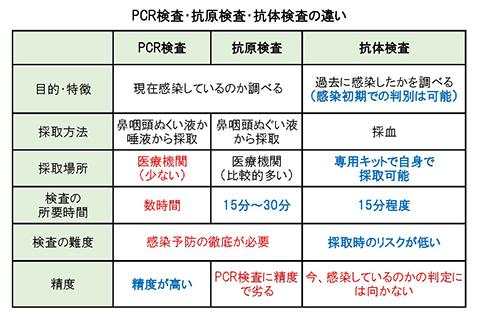What is the difference between the new corona "antigen test", "antibody test", and "PCR test"?
[Table] Differences between PCR tests, antigen tests, and antibody tests
As the epidemic of the new coronavirus infection continues, the words "antibody" test and "antigen" test that you hear in the news. The word “antibody” appears in news reports about vaccines that are currently being developed around the world. "Antibody" and "antigen" differ only by one kanji character, but they are completely different things. These appear in the "immunity" mechanism of our body, but I will explain what antigen tests and antibody tests are and what they are looking at. [Illustration] What are the "antigens" and "antibodies" that are attracting attention in new corona tests? "Learn from the mechanism of immunity"
●"Foreign substances = antigens" and "weapons = antibodies" that attack them
What is immunity in the first place? Roughly speaking, immunity is "a mechanism that distinguishes between ``self'' and ``non-self'' foreign substances and eliminates foreign substances." At that time, the “weapon” used by the immune system to eliminate foreign substances is the antibody, and the target that the immune system, including the antibody, eliminates is the antigen. Usually, "foreign substances other than yourself" are called antigens, but not only foreign substances (viruses, bacteria, pollen, parasites, etc.) that enter from outside, but also abnormal states such as cancer cells Your own cells that have become infected will also be attacked by the immune system.

[Figure 1] The process of making antibodies
Various types of cells (immune cells = so-called white blood cells) that support the immune system are a "body defense force" that cooperates to find and destroy foreign substances. I made a diagram of their complex defense system (against viruses) (Fig. 1). I've omitted this quite a bit. "Antibody" appears in this defense system.
[Figure 2] Shape of antibody
Antibodies prevent the virus from emerging from infected cells (infected cells) and trying to enter other cells. Basically, it has a "Y" shape, and if the shape of the tip of the fork fits perfectly with the foreign antigen, it sticks to it. This is called an "antigen-antibody reaction" and has functions such as nullifying (= neutralizing) the ability of the virus to infect.
● PCR test = Is there a virus in the body now?
Let's move on to testing. Antigen tests and antibody tests are tests that use this antigen-antibody reaction. So what are they looking at? First, let's take a look at the characteristics of the PCR test that has been used since the early days of the spread of infection in the spring of 2020 in order to compare the antigen test and the antibody test. This test will tell you if you have the virus in your body. "PCR" is an abbreviation for polymerase chain reaction, which is a chemical reaction for amplifying a specific region in genetic material such as DNA and RNA. The presence of the virus in the sample is confirmed by PCR enriching only the sequences unique to the target virus. The PCR test has the highest ability to detect the presence of the virus in the new coronavirus infection and is also used for definitive diagnosis. However, the virus cannot be detected unless the minimum amount of genetic material necessary for amplification can be collected, and the sensitivity is about 80% (*1) even at the timing when the amount of virus in the body is the highest, and at other timings. is expected to be even less sensitive. Therefore, it cannot be said that "negative = not infected". Conversely, in the case of a positive test, although there are not zero cases of "false positives" such as those reported by gymnast Kohei Uchimura, the probability of a true positive test is extremely high. It should be noted that PCR tests do not tell whether the detected virus is infectious or not. (*1) Sensitivity: The percentage of true positives that can be correctly identified as positive by the test
